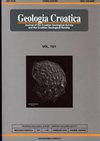社论:以克罗地亚为例,在小型滑坡研究中使用高分辨率激光雷达扫描
IF 1.1
4区 地球科学
Q3 GEOLOGY
引用次数: 0
摘要
本期75/1主要讨论山体滑坡对环境的影响,由于目前的气候变化,这种影响在世界各地和克罗地亚共和国正变得越来越明显。六篇论文(BOSTJANČIĆ et al., 2022,图1多边形1;FILIPOVIĆ等人,2022,图1多边形2;FRANGEN et al., 2022,图1多边形3;GULAM等人,2022,图1多边形4;PODOLSZKI等人,2022,图1多边形5;POLLAK等人,2022年,图1多边形6)专注于滑坡,这是克罗地亚地质调查局的一个大型团队的工作成果,该团队在safEarth项目框架内进行,由ERDF和欧盟IPA II基金共同资助。作为Interreg IPA -克罗地亚-波斯尼亚和黑塞哥维那-黑山2014-2020年跨境合作方案的一部分,安全地球项目以四个伙伴机构的跨境合作为基础,即克罗地亚地质调查局(牵头伙伴)、黑山地质调查局、矿业学院、图兹拉大学地质与土木工程与发展机构Žepče d.o.o.主要项目活动集中在滑坡易感性图(LSM)上,这是空间规划中最重要的数据集之一,在基于克罗地亚实例的小型滑坡研究中使用高分辨率激光雷达扫描本文章由计算机程序翻译,如有差异,请以英文原文为准。
Editorial: The use of high-resolution LiDAR scanning in the research of small landslides based on Croatian examples
This issue, 75/1 is mostly dedicated to the environmental impact of landslides, which, due to current climate change, are becoming more and more pronounced around the world and in the Republic of Croatia. The six papers (BOSTJANČIĆ et al., 2022, Fig. 1 poly gon 1; FILIPOVIĆ et al., 2022, Fig. 1 polygon 2; FRANGEN et al., 2022, Fig. 1 polygon 3; GULAM et al., 2022, Fig. 1 polygon 4; PODOLSZKI et al., 2022, Fig. 1 polygon 5; POLLAK et al., 2022, Fig. 1 polygon 6) focusing on landslides are the result of the work of a large team of people from the Croatian Geological Sur vey, carried out within the framework of the safEarth project, cofinanced by the ERDF and IPA II funds of the European Union. As a part of the Interreg IPA – Cross-border Cooperation Programme Croatia – Bosnia and Herzegovina – Montenegro 2014-2020, the safEarth project was based on cross-border coop eration of four partner institutions, namely the Croatian Geological Survey (lead partner), Geological Survey of Montenegro, Faculty of Mining, Geology and Civil Engineering of the Univer sity of Tuzla and the Development Agency Žepče d.o.o. The main project activities were focused on landslide susceptibility maps (LSM) as one of the most important data sets in spatial planning The use of high-resolution LiDAR scanning in the research of small landslides based on Croatian examples
求助全文
通过发布文献求助,成功后即可免费获取论文全文。
去求助
来源期刊

Geologia Croatica
GEOSCIENCES, MULTIDISCIPLINARY-
CiteScore
2.90
自引率
23.10%
发文量
35
审稿时长
>12 weeks
期刊介绍:
Geologia Croatica welcomes original scientific papers dealing with diverse aspects of geology and geological engineering, the history of the Earth, and the physical changes that the Earth has undergone or it is undergoing. The Journal covers a wide spectrum of geology disciplines (palaeontology, stratigraphy, mineralogy, sedimentology, petrology, geochemistry, structural geology, karstology, hydrogeology and engineering geology) including pedogenesis, petroleum geology and environmental geology.
Papers especially concerning the Pannonian Basin, Dinarides, the Adriatic/Mediterranean region, as well as notes and reviews interesting to a wider audience (e.g. review papers, book reviews, and notes) are welcome.
 求助内容:
求助内容: 应助结果提醒方式:
应助结果提醒方式:


